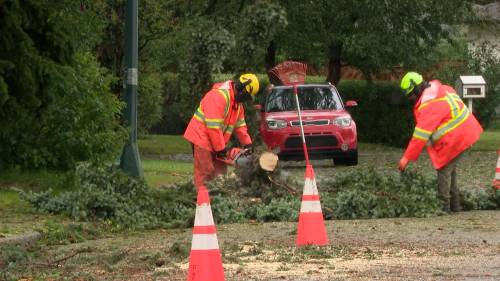A massive cleanup operation is underway across Calgary after a powerful storm system tore through the city Wednesday evening, leaving a trail of destruction that has united residents in recovery efforts. The intense weather event, characterized by wind gusts exceeding 100 km/h, toppled trees, damaged homes, and knocked out power to thousands of residents in what meteorologists are calling one of the most significant summer storms to hit the region in recent years.
“It sounded like a freight train coming through,” said Michelle Donovan, a resident of the hard-hit Beltline neighborhood, where century-old trees were uprooted and scattered across streets and properties. “One minute it was just raining, and the next, everything was flying. We’re just grateful no one on our street was hurt.”
The Calgary Emergency Management Agency has coordinated with city crews working around the clock to clear debris and restore essential services. As of Thursday afternoon, approximately 5,000 residents remain without power as ENMAX crews tackle the challenging restoration process, prioritizing critical infrastructure and areas with vulnerable populations.
City officials have established three temporary debris collection sites across Calgary, allowing residents to dispose of fallen branches and storm waste. The community response has been remarkable, with neighbors helping neighbors in what has become a city-wide restoration effort.
“We’ve seen Calgarians at their best during difficult circumstances before, and this is no exception,” Mayor Jyoti Gondek told reporters during a morning press briefing. “The resilience and community spirit shown in the aftermath of this storm speaks to the character of our city.”
The financial impact of the storm remains under assessment, but insurance experts project damages could reach into the millions. The Insurance Bureau of Canada has dispatched additional adjusters to the region to handle the influx of claims related to roof damage, vehicle impacts, and flooding.
Environmental scientists from the University of Calgary have noted that while summer storms are common in Alberta, the intensity of recent weather events aligns with climate change predictions for the region. Dr. Arlene Thompson, a climatologist at the university, explained, “What we’re seeing is consistent with models predicting more frequent and severe weather events as our climate continues to warm. These aren’t just isolated incidents anymore.”
Local businesses have joined the recovery effort, with several hardware stores offering discounts on cleanup supplies and restoration materials. Community centers across the affected areas have opened their doors to residents needing temporary shelter or access to power for essential medical equipment.
The storm has also highlighted infrastructure vulnerabilities in some of Calgary’s older neighborhoods, where aging power grids and mature tree canopies created a perfect scenario for widespread outages. City planners are already discussing longer-term resilience strategies to better prepare for future extreme weather events.
As Calgary begins the arduous process of returning to normal, questions emerge about the city’s preparedness for increasingly severe weather patterns. With climate scientists predicting more frequent extreme weather events across the Canadian prairies, will infrastructure investments keep pace with these changing realities, or is this cleanup just a preview of challenges to come?

























